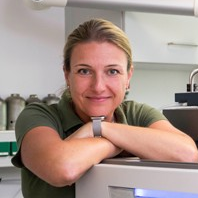Mass Spectrometric Proteomics II
A special issue of Molecules (ISSN 1420-3049). This special issue belongs to the section "Analytical Chemistry".
Deadline for manuscript submissions: closed (15 January 2021) | Viewed by 51838
Special Issue Editors
Interests: mass spectrometry coupled to mono- and two-dimensional liquid chromatography; MudPIT; clinical proteomics; systems biology; personalized medicine; computational tools for proteomics
Special Issues, Collections and Topics in MDPI journals
Interests: mass spectrometry; MALDI; LC-MS; ion mobility; mass spectrometry imaging; spatial omics; tissue morphology; native mass spectrometry; collision induced dissociation; structure elucidation; protein characterization; proteomics; glycomics; metabolimics; bacterial interactions; skin; cancer; precision medicine
Interests: proteomics; mass spectrometry; maldi; lc-ms; amyloid characterization; clinical proteomics; mass spectrometry-based quantification; targeted proteomics; post-translational modifications; protein–protein interaction; protein biochemistry; biomarkers discovery
Special Issues, Collections and Topics in MDPI journals
Special Issue Information
Dear Colleagues,
In the last two decades, the investigation of genome, including transcriptome, has been widely applied and has permitted us to improve our undestanding of it; however, at the same time, it has increased the demand to characterize other -omes sectors, such as proteome and metabolome, in order to find a complete description at molecular level of the biological mechanisms.
In addition, the improvements of both proteomics applications and related hypenated techniques, such as mono- and two-dimensional chromatography coupled to tandem mass spectrometry, have permitted us to develop the so-called mass spectrometry-based proteomics. Today, the MS-based approach has become the gold standard for proteomics study, as it allows the identification of thousands proteins for each analysis and the investigation of a wide range of samples, without limits concerning molecular weight, isoelectric point or hydrophobicity, including protein aggregates.
This Special Issue on “Mass Spectrometric Proteomics” will cover several topics, including but not limited to:
- Proteome analysis;
- Study of protein–protein interactions;
- Clinical proteomics;
- Proteomics for biomarker discovery;
- Proteomics for amyloid investigations;
- Quantitative proteomics by label-free or label-based approaches;
- Mass spectrometry analysis for the identification and the characterization of post-translational modifications (PTMs);
- Study of protein structure by mass spectrometry;
- MS-based proteomics imaging;
- Development of new analytical MS-based methods.
We warmly invite our colleagues to submit their original contributions to this Special Issue in order to provide recent updates regarding analytical MS-based methods for proteomics that will be of interest to our readers, including o-line separation techniques; native and structural analysis;,such as hydrogen deuterium exchange (HDX); cross-linking and top–down; imaging; data-independent analysis (DIA); protein–protein interactions and single cell analysis; and integration with dedicated computational tools.
We would be delighted if you could respond to confirm your contribution and the proposed title by 30 September 2020 to assist in planning the whole project.
Prof. Pierluigi Mauri
Prof. Martina Marchetti-Deschmann
Dr. Diana Canetti
Guest Editors
Manuscript Submission Information
Manuscripts should be submitted online at www.mdpi.com by registering and logging in to this website. Once you are registered, click here to go to the submission form. Manuscripts can be submitted until the deadline. All submissions that pass pre-check are peer-reviewed. Accepted papers will be published continuously in the journal (as soon as accepted) and will be listed together on the special issue website. Research articles, review articles as well as short communications are invited. For planned papers, a title and short abstract (about 100 words) can be sent to the Editorial Office for announcement on this website.
Submitted manuscripts should not have been published previously, nor be under consideration for publication elsewhere (except conference proceedings papers). All manuscripts are thoroughly refereed through a single-blind peer-review process. A guide for authors and other relevant information for submission of manuscripts is available on the Instructions for Authors page. Molecules is an international peer-reviewed open access semimonthly journal published by MDPI.
Please visit the Instructions for Authors page before submitting a manuscript. The Article Processing Charge (APC) for publication in this open access journal is 2700 CHF (Swiss Francs). Submitted papers should be well formatted and use good English. Authors may use MDPI's English editing service prior to publication or during author revisions.
Keywords
- Proteomics
- Mass Spectrometry
- Aggregated proteins/amyloid
- Native/structural analysis
- Emergeting DIA and single-cell approaches
- Targeted proteomics
- Imaging
- Top Down
- Protein–protein interactions
- Quantitation
- Biomarkers discovery
- Post-translational modifications (PTMs)
Benefits of Publishing in a Special Issue
- Ease of navigation: Grouping papers by topic helps scholars navigate broad scope journals more efficiently.
- Greater discoverability: Special Issues support the reach and impact of scientific research. Articles in Special Issues are more discoverable and cited more frequently.
- Expansion of research network: Special Issues facilitate connections among authors, fostering scientific collaborations.
- External promotion: Articles in Special Issues are often promoted through the journal's social media, increasing their visibility.
- Reprint: MDPI Books provides the opportunity to republish successful Special Issues in book format, both online and in print.
Further information on MDPI's Special Issue policies can be found here.








